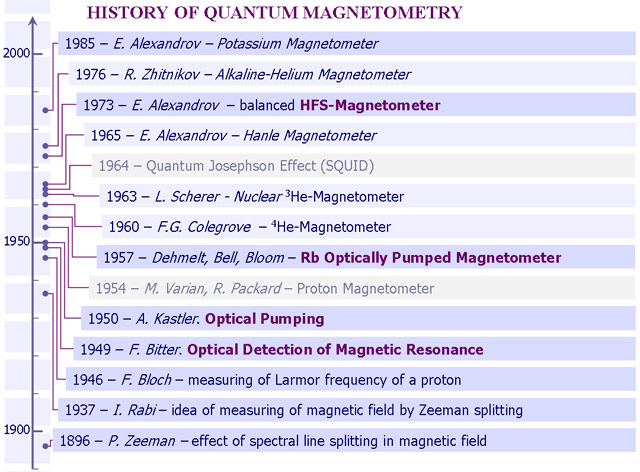Overview Atomic RadioSpectroscopy Lab was founded in 2004 when
Prof. E.B.Alexandrov Quantum Magnetometry Lab, founded in 1960s in S.I.Vavilov State Optical Institute and partially moved in
Ioffe PTI in 1999, and Prof. R.A.Zhitnikov Atomic RadioSpectroscopy Group, working in Ioffe PTI since early 70-es,
were merged together. At that moment both research groups had huge experience in investigation of processes of interaction of atom with resonant optical and radiofrequency fields
and the applications of these processes to quantum magnetometry and to the other scientific and practical tasks.
Atomic RadioSpectroscopy Lab was founded in 2004 when
Prof. E.B.Alexandrov Quantum Magnetometry Lab, founded in 1960s in S.I.Vavilov State Optical Institute and partially moved in
Ioffe PTI in 1999, and Prof. R.A.Zhitnikov Atomic RadioSpectroscopy Group, working in Ioffe PTI since early 70-es,
were merged together. At that moment both research groups had huge experience in investigation of processes of interaction of atom with resonant optical and radiofrequency fields
and the applications of these processes to quantum magnetometry and to the other scientific and practical tasks.
As it was before merging, the processes of Optical Orientation of Atoms and Magnetic Resonance caused by interaction of optically polarised atom systems with radio fields of a wide frequency range are now actively investigated in the laboratory. Quantum Magnetometry is the most direct practical application of Optical Orientation. The lab is well-known worldwide for inventing and developing super-precise and sensitive scalar and vector magnetometers, based on optical pumping of alkaline and helium atoms. 
The lab also specializes in Inter-Atomic and Atomic-Molecular Spin-Dependent Interactions in Gases and Gas Discharge Plasma;
Both elastic and inelastic processes taking place at the interaction between the spin-polarized excited atom and paramagnetic ground state atom or molecule in gas discharge,
are being studied as well as their influence on the spin exchange and frequency shift cross section values.
Another direction of the research includes Spin-Dependent Processes in Condensed Matter such as cryogenic crystals, semiconductor nano-structures, and superconductive nano-structures; the studies of the spin-dependent carrier transport and of the nuclear magnetic resonance (NMR) as well as electrically/optically induced nuclear polarization and electrically/optically detected EPR (ESR) and NMR in both bulk and low-dimensional semiconductor structures. Techniques being developed in the lab allow the preparation of different kinds of silicon nanostructures such as ultra-narrow quantum wells, split-gated quantum wires, dots, one-dimensional rings and superconductor-silicon quantum well-superconductor sandwich-structures. The lab also participates in a very ambitious international projects devoted to search for a neutron electric dipole moment (EDM) and to other Ultracold Neutrons Experiments. For the needs of these projects the 8-sensors quantum magnetometer system was developed allowing to stabilize the neutron magnetic resonance at picoTesla level. |